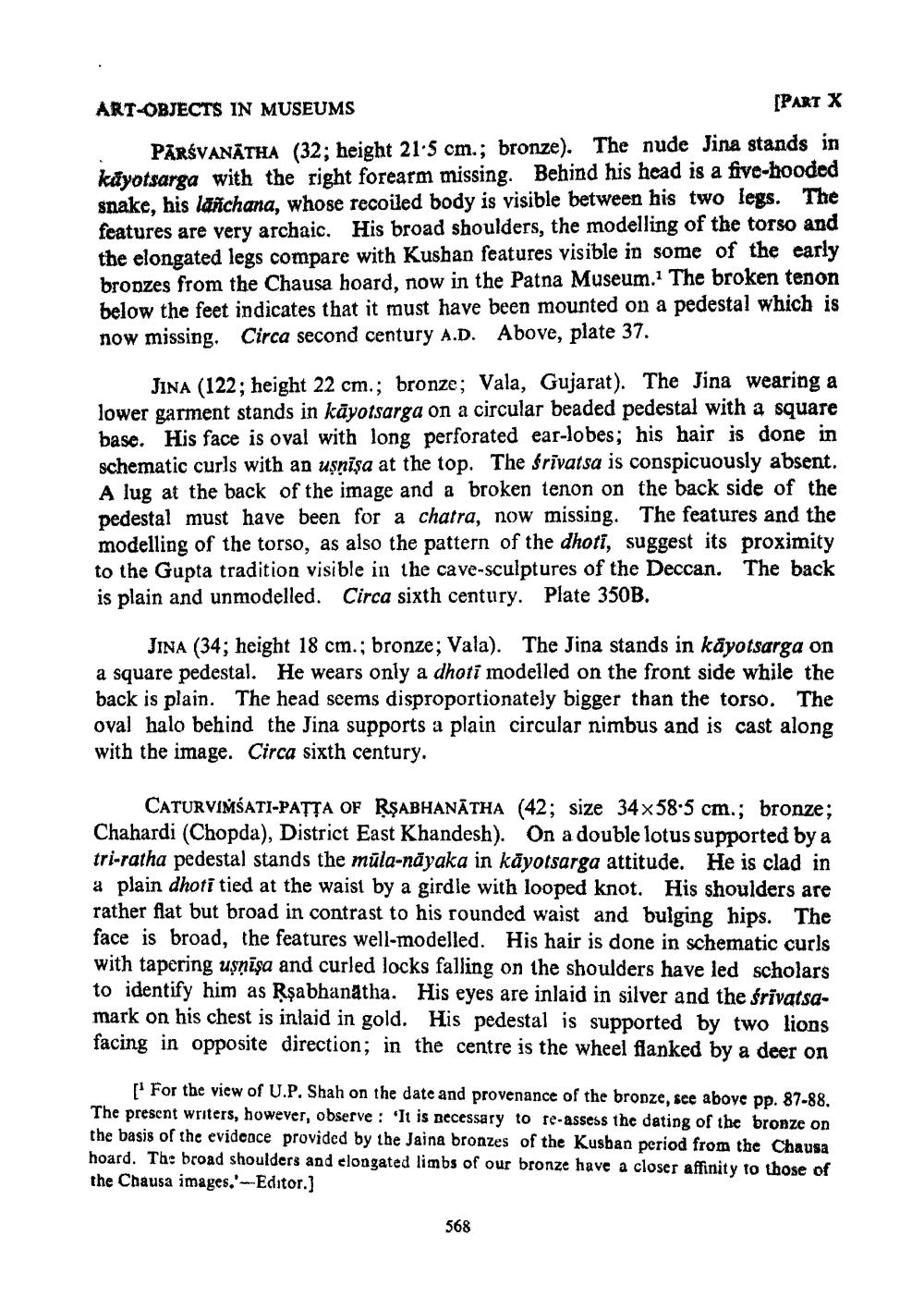________________
ART-OBJECTS IN MUSEUMS
[PART X
PĀRSVANÄTHA (32; height 21.5 cm.; bronze). The nude Jina stands in küyotsarga with the right forearm missing. Behind his head is a five-hooded snake, his lanchana, whose recoiled body is visible between his two legs. The features are very archaic. His broad shoulders, the modelling of the torso and the elongated legs compare with Kushan features visible in some of the early bronzes from the Chausa hoard, now in the Patna Museum. The broken tenon below the feet indicates that it must have been mounted on a pedestal which is now missing. Circa second century A.D. Above, plate 37.
JINA (122; height 22 cm.; bronze; Vala, Gujarat). The Jina wearing a lower garment stands in kāyotsarga on a circular beaded pedestal with a square base. His face is oval with long perforated ear-lobes; his hair is done in schematic curls with an usniņa at the top. The frivatsa is conspicuously absent. A lug at the back of the image and a broken tenon on the back side of the pedestal must have been for a chatra, now missing. The features and the modelling of the torso, as also the pattern of the dhoti, suggest its proximity to the Gupta tradition visible in the cave-sculptures of the Deccan. Ti is plain and unmodelled. Circa sixth century. Plate 350B.
JINA (34; height 18 cm.; bronze; Vala). The Jina stands in kāyotsarga on a square pedestal. He wears only a dhoti modelled on the front side while the back is plain. The head seems disproportionately bigger than the torso. The oval halo behind the Jina supports a plain circular nimbus and is cast along with the image. Circa sixth century,
CATURVIMŠATI-PATTA OF RŞABHANATHA (42; size 34 x 58.5 cm.; bronze; Chahardi (Chopda), District East Khandesh). On a double lotus supported by a tri-ratha pedestal stands the müla-näyaka in kayotsarga attitude. He is clad in a plain dhoti tied at the waist by a girdle with looped knot. His shoulders are rather flat but broad in contrast to his rounded waist and bulging hips. The face is broad, the features well-modelled. His hair is done in schematic curls with tapering usnīşa and curled locks falling on the shoulders have led scholars to identify him as Rşabhanatha. His eyes are inlaid in silver and the srivatsamark on his chest is inlaid in gold. His pedestal is supported by two lions facing in opposite direction; in the centre is the wheel flanked by a deer on
hips. The
snīsa and curled locks failed. His hair is done in a
[ For the view of U.P. Shah on the date and provenance of the bronze, see above pp. 87-88. The present writers, however, observe: 'It is Becessary to re-assess the dating of the bronze on the basis of the evidence provided by the Jaina bronzes of the Kusban period from the Chausa hoard. The broad shoulders and elongated limbs of our bronze have a closer affinity to those of the Chausa images.' ---Editor.]
568




